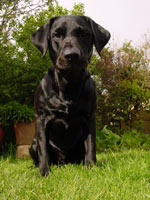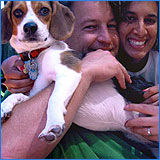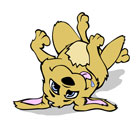Labrador Retriever Dog Breed
Dog Group: Sporting Group
Class: Gun Dog
Description

Labrador Retrievers are beautiful dogs, with a sturdy, athletic build. The colors of these dogs are chocolate, black or yellow, and they have short, thick coats with very straight hair. The coat of a Labrador Retriever is double-layered and dense, providing the dog with effective water and weather protection and making for easy maintenance. The eyes of this breed usually range from dark to mid-brown depending on the color of the dog’s coat. Labrador Retrievers have a distinctive broad head, with a wide muzzle and thick nose. The otter tail and webbed feet are also very distinctive features of this dog breed.
Temperament
Labrador Retrievers are intelligent, as well as very good with children and the elderly, making them ideal family pets. This breed is generally good-natured and amiable, with bags of energy and a real loyal streak. They are not usually aggressive dogs, although they will be protective of their family and will voice a warning to anyone they think is a threat or a stranger. Labrador Retrievers are gentle, dependable and usually very loving pets that enjoy the company of humans. In fact, their gentle disposition and intelligence has earned them the honor of being one of the main breeds used as rescue and guide dogs.
Height and Weight
The height and weight of these dogs when they reach adulthood differs between the sexes. Labrador Retrievers are strong and sturdy in build, and males can weigh around between 65-80 pounds, with females not far behind at around 55-70 pounds.
The height of Labrador Retrievers also differs between the sexes, and males are generally around 22-24 inches, with females at around 21-23 inches. Obviously the weight and height guides are approximate and may differ from one dog to the next.
Common Health and Behavioral Problems
There are several common health issues that can affect Labrador Retrievers. Elbow or hip dysplasia is a condition that can affect a variety of larger dog breeds, and because it is a degenerative problem can cause problem such as arthritis, mobility problems, and a great deal of discomfort and swelling. This is caused by the abrasion of the bones and cartilage in the affected area, which becomes displaces.
Progressive Retinal Atrophy is another common health problem in Labrador Retrievers, and this can also affect many other breeds. Known as PRA, it is an inherited and non-curable disorder that affects the retina of both eyes at the same time, causing severe reduction or loss of vision.
Ideal Living Conditions
Labrador Retrievers are very adaptable dogs, and will fit into all sort of living environments. However, they are energetic, particularly when younger, and it is therefore better for them to have some space and a garden or back yard in which to get some exercise.
Exercise Requirements
Because Labrador Retrievers are energetic dogs, they do need regular exercise. This will help to keep them healthy and happy as well as help to control their weight. These dogs love to play and can enjoy getting a great deal of exercise through play and interactive activity with their owners and family. Their love for company and people means that interactive play such as Frisbee, fetch etc. can provide them with mental stimulation as well as much-needed exercise.
Diet and Nutrition
Labrador Retrievers do tend to have healthy appetites – one of the reasons why regular exercise is so important, to keep off unwanted weight. Labrador Retrievers do have a tendency to become obese so food portions should be carefully monitored. You should take care not to be generous with the treats and snacks. A complete dog food of good quality, supplemented with some fresh home-cooked food from time to time will keep his diet varied and balanced. The amount, type and regularity of food will depend upon the age and health of the individual Labrador Retriever.
Life Expectancy
The life expectancy of Labrador Retrievers is around ten to twelve years, although this will obviously vary depending in the individual dog’s health and condition. Like all other breeds, his life expectancy potential can be maximized through healthy lifestyle such as a stable and balanced diet, regular exercise, plenty of interaction to stimulate his mind and body, and of course regular check-ups and vaccinations.
Grooming Requirements
The coat of a Labrador Retriever is generally easy to maintain because of the short, sleek hair. Regular brushing with a bristle brush will keep his coat sleek and healthy, you can buy a range of dry shampoo products that can be used during grooming. You should take the time during his grooming session to check for any abnormalities such as discharge or infestation, as this will help to identify and deal with any potential problems early on.
Origin
This popular breed of dog originates from Newfoundland, and was once popular for accompanying fishermen to England , where they quickly became popular. Their sporting and hunting (or retrieving) skills meant that they soon soared in popularity as hunting and sporting dogs in England. In 1904 the Labrador Retriever was recognized as a breed in England in 1904, and then by the American Kennel Club around a decade later.
 |
 |
Secrets to Dog Training Testimonials
 "Hi Daniel, I am actually using your expert advice this week. A while ago I wrote in that my mother's dog, a four year old brown lab named Molly, was coming to stay with us for a week. My husband and I have a 1-year old beagle named Bernie. Bernie is very playful. And Molly is receptive at first but after a little while, she tires of Bernie and her constant source of energy. Molly is very much "Let's rest a while" and Bernie is "Play with me! Look at me! Why aren't you playing or looking at me!" When it gets to be too much, Molly tries to show her dominance in creative ways.
"Hi Daniel, I am actually using your expert advice this week. A while ago I wrote in that my mother's dog, a four year old brown lab named Molly, was coming to stay with us for a week. My husband and I have a 1-year old beagle named Bernie. Bernie is very playful. And Molly is receptive at first but after a little while, she tires of Bernie and her constant source of energy. Molly is very much "Let's rest a while" and Bernie is "Play with me! Look at me! Why aren't you playing or looking at me!" When it gets to be too much, Molly tries to show her dominance in creative ways.
I feared that I would have to keep them apart the entire week Molly was visting. So I wrote to your site and was advised that by already treating Molly like the dominant dog (even though it was Bernie's house) Molly wouldn't have to take matters into her own paws. By greeting Molly first and feeding her first, both dogs would get the hint. And it's been working!
Bernie still loves to play but thanks to your techniques, my husband and I have been able to give Molly some relief and keep her from acting out too aggresively when she has had enough of our Bernie. Now Bernie and Molly can pal around without much trouble. Attached is our picture with Bernie. I can send one of Bernie and Molly if you'd like. Thanks and best wishes."
-- Tahara Lo (USA)
More Resources
 |
 |
Want to find out about more dog breeds? Search here or go to our Dog Breed index.
Got Dog Obedience Training or Problem Behavior Issues?
Is your dog trying your patience on a daily basis? Are you constantly faced with a dog that displays one of the following issues? To find the solution to your problem click on it.. you'll discover the answers to it and other common dog problems you may be facing.
This is the most comprehensive book on dog training and behavior problems around. Best of all... You can download this book to your computer and be reading and using the professionals training techniques in minutes.
About The Author
Daniel Stevens is the renowned dog trainer and author of Secrets to Dog Training: STOP Dog Behavior Problems!, one of the leading dog training guides on the market today selling over 25,743 copies (and counting). He currently heads the Kingdom of Pets dog training team.

